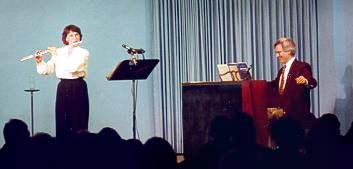The Beginnings of Music:
|
Every note, in order to be itself, needs to be played or sung. So along with the note, the musical instrument belongs to the beginnings of music. I am tremendously grateful to Eli Siegel and Aesthetic Realism that I learned from them the reason why people have, since they lived in the caves of France over 34,000 years ago—why they have been impelled to make and play musical instruments. It is because these instruments enable us to put opposites together—ourselves and the world. Every instrument is made from materials to be found in the world—wood, silver, brass, ivory, gold. And every instrument must be played by a person. So when a note is played on an instrument, what we hear and see is a successful oneness of a person and the world. These are, Aesthetic Realism teaches, the first opposites for a person—self and world—and we are trying to do a good job with these opposites from birth.We can imagine what it was like when the first person raised a reed to his mouth, blew across it—perhaps to imitate the wind—and heard a sound. The first musician and the musician today have this in common: The instrument he plays is a means of joining himself to the whole world. What Do Musical Instruments Mean? Since the earliest times there have been three kinds of instruments which can play a note. There are the instruments which are hit—percussion; instruments which are plucked and bowed—stringed-instruments; and instruments which are blown. Now we can ask: What does this mean?
In The Right of Aesthetic Realism to Be Known #93, Eli Siegel writes this:
And later: Listen:
|
 Chinese flute |
Sometimes we feel explosive. sometimes we have sharp thoughts which linger and die away. And sometimes we feel more continuous. We are all three. But the way we feel explosive and the way we feel things are continuous very often does not make as much sense as the sounds we just heard. Once in an Aesthetic Realism class Eli Siegel asked me: "Have you ever spent a whole day in one dark mood?" "Yes," I said. Then there can be a day when everything seems to be discontinuous, and from the time we get up till the time we go to bed, we feel like an entire percussion section is going crazy inside us—one thing after another. Boredom and agitation are painful forms of the same opposites all musical instruments put together—continuity and surprise; junction and separation. People have been affected by these opposites for a very long time, and have wanted to put them together well. We can hear this in an English Dance of the 13th century, where the drum, and two wind instruments—instruments which accent separation and instruments that accent junction—play together in a very lively manner. [Play a 30 sec. section with a slow fade—Festive Pipes] The next example is predominantly the flute and the drum accompanied by the drone of a reed-box in this selection from the music of India. Though the instruments are in the same family as in the English dance, the sounds are very, even strangely different. You will still be hearing the sharp raps of the drum with the continuous, rather sinuous sound of the flute. [Play 15 sec. of flute and drum, India] What this means is that people the world over want to compose the opposites of continuity and surprise through sounds that are joined and sounds that are separate. Why we are so affected by the oneness of these opposites is explained in the chapter "The Aesthetic Method in Self-Conflict" from Self and World where Eli Siegel writes: |
Copyright © 2000-2020 Barbara Allen, Aesthetic Realism Consultant
